Charcot-Marie-Tooth disease Type 1 (CMT1)
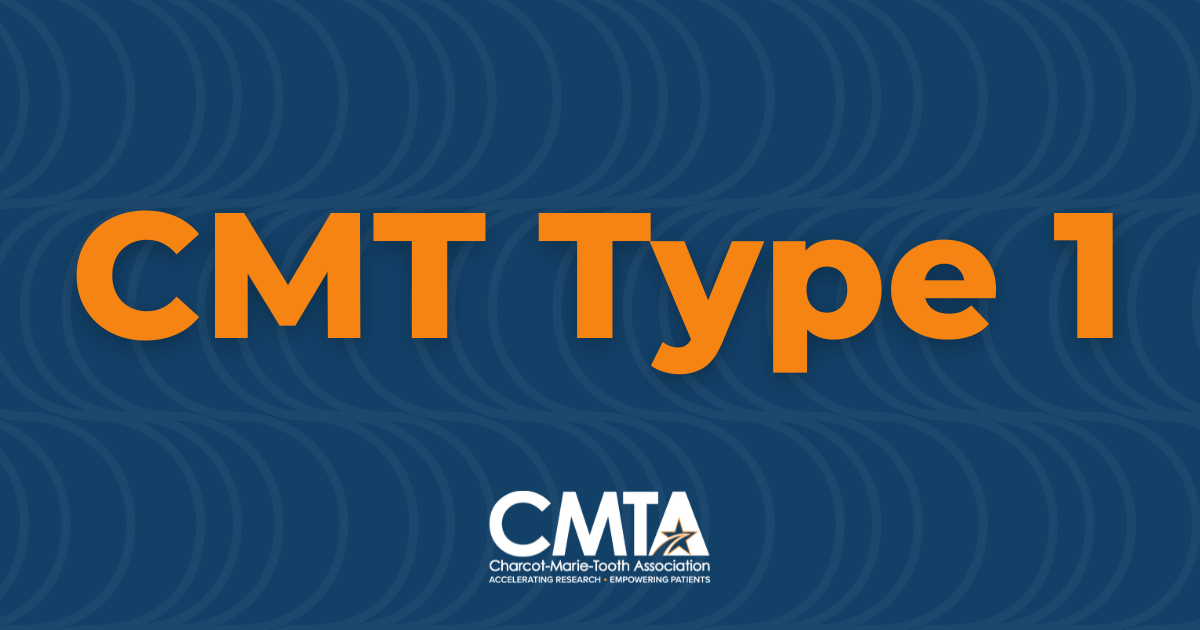
What is CMT Type 1?
CMT Type 1 (CMT1) is defined as an autosomal dominant (see inheritance) demyelinating form of CMT. CMT1 accounts for about 55 percent of all cases of CMT. (More about CMT Type 1: CMT_Type_1_Causes_Symptoms.pdf)What causes CMT1
CMT1 is caused by a variety of gene mutations. The gene that is mutated determines the subtype of CMT1 that a person has. Mutations that can cause type 1 include:
- CMT1A, CMT1E – Peripheral myelin protein 22 (PMP22)
- CMT1B – Myelin protein zero (MPZ/P0)
- CMT1C – Lipopolysaccharide-induced tumor necrosis factor-alpha factor (LITAF/SIMPLE)
- CMT1D – Early growth response 2 (EGR2/Krox20)
- CMT1F – Neurofilament light polypeptide (NEFL)
- CMT1G – Peripheral myelin protein 2 (PMP2)
- CMT1H – fibulin 5 gene (FBLN5)
- CMT1I – polymerase III, RNA, subunit B gene (POLR3B)
- CMT1J – inositol 1,4,5-trisphosphate receptor, type 3 (ITPR3)
What are the Symptoms of CMT1
Affected patients may experience:
- weakness, atrophy, and sensory loss in the distal legs followed by the distal arms
- foot deformities and areflexia (absence of neurological reflexes such as knee jerk reaction) are sometimes present
There is considerable variability in the degree of neurological deficits within families, and even between identical twins, indicating that other factors modulate disease severity. Examinations of sensory and motor function worsen gradually. Atypical presentations are reported, including cranial nerve involvement, proximal weakness, diaphragmatic weakness, calf hypertrophy, and cramps.
When do symptoms of CMT1 start?
The age of onset of CMT1 varies. Onset can appear anywhere from infancy to later decades of life (40, 50, etc.). Patients usually have first symptoms between the first and second decades of life. Other clinical manifestations may appear later.
What are the Type 1 Subtypes?
This section is being updated. Please refer to the above section for the full list of CMT Type 1 subtypes currently known and their associated gene mutations.
-
-
Type 1A
 CMT1A is the most common form of CMT, comprising around 66 percent of all patients with CMT1. The disorder is caused by a duplication of the PMP22 gene on Chromosome 17. Instead of having two copies of the gene (one from each parent), there are three copies, two on one chromosome and one on the other. PMP22 is a peripheral myelin protein, but its exact function in causing CMT is still not known. CMT1A usually presents with a typical CMT phenotype (clinical presentation). Usually, people with CMT1A are slow runners in childhood, develop high arches and hammertoes and often require orthotics (braces) for ankle support. Varying degrees of hand weakness occur, often appearing as much as 10 years after foot and leg problems. Problems with balance because of ankle weakness and loss of proprioception (the brain’s ability to know where the limbs are in space) are common. Most patients (95 percent) remain ambulatory throughout their lives and life expectancy is normal.
Research on CMT Type 1A
CMT1A is the most common form of CMT, comprising around 66 percent of all patients with CMT1. The disorder is caused by a duplication of the PMP22 gene on Chromosome 17. Instead of having two copies of the gene (one from each parent), there are three copies, two on one chromosome and one on the other. PMP22 is a peripheral myelin protein, but its exact function in causing CMT is still not known. CMT1A usually presents with a typical CMT phenotype (clinical presentation). Usually, people with CMT1A are slow runners in childhood, develop high arches and hammertoes and often require orthotics (braces) for ankle support. Varying degrees of hand weakness occur, often appearing as much as 10 years after foot and leg problems. Problems with balance because of ankle weakness and loss of proprioception (the brain’s ability to know where the limbs are in space) are common. Most patients (95 percent) remain ambulatory throughout their lives and life expectancy is normal.
Research on CMT Type 1A
-
-
-
Type 1B
 CMT1B is caused by mutations in the MPZ, or peripheral myelin protein, gene. There is a wide range of severity within CMT1B, from very severe, infantile onset to milder cases with onset much later in life. About 40 percent of people with CMT1B have an infantile onset with delayed walking (after 15 months), and development of symptoms before 5 years of age. Hip dysplasia and optic nerve atrophy have been observed in this group (though hip dysplasia may happen in up to 20 percent of kids with CMT), and scoliosis in about a third of people. People with early-onset CMT1B tend to have very slow nerve conduction velocities, with speeds <15 m/s in the arms (normal >50 m/s). A minority (7 percent) of people with this disease-causing variant in the MPZ gene have a childhood onset, with symptoms between 6 and 20 years of age. This group tends to have slow nerve conductions, between 15 and 25 m/s. The remainder of people with CMT1B have an adult onset, with symptoms tending to begin after age 40 and a comparatively milder presentation. Their nerve conduction studies tend to be in the intermediate range of between 35 and 45 m/s.
Research on CMT Type 1B
CMT1B is caused by mutations in the MPZ, or peripheral myelin protein, gene. There is a wide range of severity within CMT1B, from very severe, infantile onset to milder cases with onset much later in life. About 40 percent of people with CMT1B have an infantile onset with delayed walking (after 15 months), and development of symptoms before 5 years of age. Hip dysplasia and optic nerve atrophy have been observed in this group (though hip dysplasia may happen in up to 20 percent of kids with CMT), and scoliosis in about a third of people. People with early-onset CMT1B tend to have very slow nerve conduction velocities, with speeds <15 m/s in the arms (normal >50 m/s). A minority (7 percent) of people with this disease-causing variant in the MPZ gene have a childhood onset, with symptoms between 6 and 20 years of age. This group tends to have slow nerve conductions, between 15 and 25 m/s. The remainder of people with CMT1B have an adult onset, with symptoms tending to begin after age 40 and a comparatively milder presentation. Their nerve conduction studies tend to be in the intermediate range of between 35 and 45 m/s.
Research on CMT Type 1B
-
-
-
Type 1C
 CMT1C is caused by disease-causing variants in the LITAF gene, also previously referred to as SIMPLE. This is a rare form of CMT, affecting fewer than 1 percent of people who have the disease. Presentation is similar to CMT1A, with onset between the first and third decades, and weakness in the feet and hands, atrophy, and sensory loss and slow nerve conduction velocities (16-25 m/s).
CMT1C is caused by disease-causing variants in the LITAF gene, also previously referred to as SIMPLE. This is a rare form of CMT, affecting fewer than 1 percent of people who have the disease. Presentation is similar to CMT1A, with onset between the first and third decades, and weakness in the feet and hands, atrophy, and sensory loss and slow nerve conduction velocities (16-25 m/s).
-
-
-
Type 1D
 CMT1D is caused by mutations in a gene on chromosome 10 called EGR2, which codes for the early growth response protein 2. CMT1D is very rare and causes less than 1 percent of cases of CMT. Most people with CMT1D show severe symptoms in the first decade of life, including delayed motor milestones and nerve conduction velocities of 10 m/s or less (sometimes referred to as Dejerine Sottas syndrome). A few cases of CMT1D have milder symptoms that appear later in life. Other symptoms may include cranial nerve dysfunction and respiratory difficulties. There have been extremely rare reports of EGR2 causing an autosomal recessive form of CMT, termed CMT4E.
CMT1D is caused by mutations in a gene on chromosome 10 called EGR2, which codes for the early growth response protein 2. CMT1D is very rare and causes less than 1 percent of cases of CMT. Most people with CMT1D show severe symptoms in the first decade of life, including delayed motor milestones and nerve conduction velocities of 10 m/s or less (sometimes referred to as Dejerine Sottas syndrome). A few cases of CMT1D have milder symptoms that appear later in life. Other symptoms may include cranial nerve dysfunction and respiratory difficulties. There have been extremely rare reports of EGR2 causing an autosomal recessive form of CMT, termed CMT4E.
-
-
-
Type 1E
 Point mutations in the PMP22 gene cause CMT1E. People with CMT1E tend to have earlier onset and more severe symptoms than those with CMT1A, but this may vary. Conduction velocities in patients tend to be markedly reduced, usually under 10 m/s (normal in the arms is >50 m/s). Children often present within the first two years of life with delayed walking. Many people do progress to needing ambulation aids, such as a walker or a wheelchair, earlier than those with CMT1A. CMT1E is a rare form of CMT, accounting for approximately one percent of people with genetically confirmed CMT.
Point mutations in the PMP22 gene cause CMT1E. People with CMT1E tend to have earlier onset and more severe symptoms than those with CMT1A, but this may vary. Conduction velocities in patients tend to be markedly reduced, usually under 10 m/s (normal in the arms is >50 m/s). Children often present within the first two years of life with delayed walking. Many people do progress to needing ambulation aids, such as a walker or a wheelchair, earlier than those with CMT1A. CMT1E is a rare form of CMT, accounting for approximately one percent of people with genetically confirmed CMT.
-
-
-
Type 1F
 CMT1F accounts for a very small percentage of cases. It is an autosomal dominant form of CMT in which the defect is on Chromosome 8 and the neurofilament light chain protein.
CMT1F accounts for a very small percentage of cases. It is an autosomal dominant form of CMT in which the defect is on Chromosome 8 and the neurofilament light chain protein.
-
-
-
Type 1J
A new CMT Subtype – CMT1J – was classified on October 31, 2022. CMT1J is an autosomal dominant demyelinating type of Charcot-Marie-Tooth disease caused by heterozygous mutation in the ITPR3 gene (147267) on chromosome 6p21. The mutation was originally identified in 2020 by Ronkko et al., but has just been given its CMT1J designation.
-
-
-
Type 1X
 CMT1X is the second most common form of CMT, accounting for 10 – 16 percent of all cases. The gene that causes CMT1X is GJB1 (previously referred to as Cx32), and the protein is called connexin 32. This gene is found on the X chromosome, one of the sex chromosomes. Females have two X chromosomes (XX) and males have an X and a Y chromosome (XY). Because males only have one copy of the X chromosome, they only have one copy of this gene. If there is a variant in the gene that causes it not to work, males do not have a “backup” copy to help make connexin 32 protein. Females have an extra copy of the gene. Females tend to be less severely affected than the males in their family, but 90 percent have some symptoms. About two-thirds of affected women have symptoms in the mild range and one-third have symptoms in the moderate range. Most males have moderate to severe neuropathy as they age.
The CMT genes found on the X chromosome have a different form of inheritance, called X-linked inheritance. In every pregnancy, the female passes down one copy of a chromosome pair and her partner passes down the other copy for the pair. In order for a child to be born female, she must inherit the X chromosome from her dad. In order for a child to be born male, he must inherit the Y chromosome from his dad. A woman will pass down one or the other of her two X chromosomes in every pregnancy. Each child of a woman affected with CMT1X has a 50/50 risk of inheriting the condition, no matter the sex of the child. A man affected with CMT1X will pass it on to ALL of his daughters (since they inherit his X chromosome with the GJB1 gene variant), but NONE of his sons (who inherit the Y chromosome which does not have a GJB1 gene). The sex of the parent or the child ONLY matters in X-linked inheritance.
Research on CMT Type 1X
CMT1X is the second most common form of CMT, accounting for 10 – 16 percent of all cases. The gene that causes CMT1X is GJB1 (previously referred to as Cx32), and the protein is called connexin 32. This gene is found on the X chromosome, one of the sex chromosomes. Females have two X chromosomes (XX) and males have an X and a Y chromosome (XY). Because males only have one copy of the X chromosome, they only have one copy of this gene. If there is a variant in the gene that causes it not to work, males do not have a “backup” copy to help make connexin 32 protein. Females have an extra copy of the gene. Females tend to be less severely affected than the males in their family, but 90 percent have some symptoms. About two-thirds of affected women have symptoms in the mild range and one-third have symptoms in the moderate range. Most males have moderate to severe neuropathy as they age.
The CMT genes found on the X chromosome have a different form of inheritance, called X-linked inheritance. In every pregnancy, the female passes down one copy of a chromosome pair and her partner passes down the other copy for the pair. In order for a child to be born female, she must inherit the X chromosome from her dad. In order for a child to be born male, he must inherit the Y chromosome from his dad. A woman will pass down one or the other of her two X chromosomes in every pregnancy. Each child of a woman affected with CMT1X has a 50/50 risk of inheriting the condition, no matter the sex of the child. A man affected with CMT1X will pass it on to ALL of his daughters (since they inherit his X chromosome with the GJB1 gene variant), but NONE of his sons (who inherit the Y chromosome which does not have a GJB1 gene). The sex of the parent or the child ONLY matters in X-linked inheritance.
Research on CMT Type 1X
-






 CMT1A is the most common form of CMT, comprising around 66 percent of all patients with CMT1. The disorder is caused by a duplication of the PMP22 gene on Chromosome 17. Instead of having two copies of the gene (one from each parent), there are three copies, two on one chromosome and one on the other. PMP22 is a peripheral myelin protein, but its exact function in causing CMT is still not known. CMT1A usually presents with a typical CMT phenotype (clinical presentation). Usually, people with CMT1A are slow runners in childhood, develop high arches and hammertoes and often require orthotics (braces) for ankle support. Varying degrees of hand weakness occur, often appearing as much as 10 years after foot and leg problems. Problems with balance because of ankle weakness and loss of proprioception (the brain’s ability to know where the limbs are in space) are common. Most patients (95 percent) remain ambulatory throughout their lives and life expectancy is normal.
CMT1A is the most common form of CMT, comprising around 66 percent of all patients with CMT1. The disorder is caused by a duplication of the PMP22 gene on Chromosome 17. Instead of having two copies of the gene (one from each parent), there are three copies, two on one chromosome and one on the other. PMP22 is a peripheral myelin protein, but its exact function in causing CMT is still not known. CMT1A usually presents with a typical CMT phenotype (clinical presentation). Usually, people with CMT1A are slow runners in childhood, develop high arches and hammertoes and often require orthotics (braces) for ankle support. Varying degrees of hand weakness occur, often appearing as much as 10 years after foot and leg problems. Problems with balance because of ankle weakness and loss of proprioception (the brain’s ability to know where the limbs are in space) are common. Most patients (95 percent) remain ambulatory throughout their lives and life expectancy is normal.
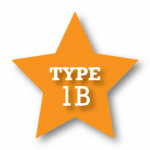 CMT1B is caused by mutations in the MPZ, or peripheral myelin protein, gene. There is a wide range of severity within CMT1B, from very severe, infantile onset to milder cases with onset much later in life. About 40 percent of people with CMT1B have an infantile onset with delayed walking (after 15 months), and development of symptoms before 5 years of age. Hip dysplasia and optic nerve atrophy have been observed in this group (though hip dysplasia may happen in up to 20 percent of kids with CMT), and scoliosis in about a third of people. People with early-onset CMT1B tend to have very slow nerve conduction velocities, with speeds <15 m/s in the arms (normal >50 m/s). A minority (7 percent) of people with this disease-causing variant in the MPZ gene have a childhood onset, with symptoms between 6 and 20 years of age. This group tends to have slow nerve conductions, between 15 and 25 m/s. The remainder of people with CMT1B have an adult onset, with symptoms tending to begin after age 40 and a comparatively milder presentation. Their nerve conduction studies tend to be in the intermediate range of between 35 and 45 m/s.
CMT1B is caused by mutations in the MPZ, or peripheral myelin protein, gene. There is a wide range of severity within CMT1B, from very severe, infantile onset to milder cases with onset much later in life. About 40 percent of people with CMT1B have an infantile onset with delayed walking (after 15 months), and development of symptoms before 5 years of age. Hip dysplasia and optic nerve atrophy have been observed in this group (though hip dysplasia may happen in up to 20 percent of kids with CMT), and scoliosis in about a third of people. People with early-onset CMT1B tend to have very slow nerve conduction velocities, with speeds <15 m/s in the arms (normal >50 m/s). A minority (7 percent) of people with this disease-causing variant in the MPZ gene have a childhood onset, with symptoms between 6 and 20 years of age. This group tends to have slow nerve conductions, between 15 and 25 m/s. The remainder of people with CMT1B have an adult onset, with symptoms tending to begin after age 40 and a comparatively milder presentation. Their nerve conduction studies tend to be in the intermediate range of between 35 and 45 m/s.
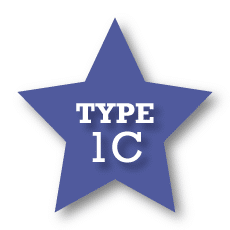 CMT1C is caused by disease-causing variants in the LITAF gene, also previously referred to as SIMPLE. This is a rare form of CMT, affecting fewer than 1 percent of people who have the disease. Presentation is similar to CMT1A, with onset between the first and third decades, and weakness in the feet and hands, atrophy, and sensory loss and slow nerve conduction velocities (16-25 m/s).
CMT1C is caused by disease-causing variants in the LITAF gene, also previously referred to as SIMPLE. This is a rare form of CMT, affecting fewer than 1 percent of people who have the disease. Presentation is similar to CMT1A, with onset between the first and third decades, and weakness in the feet and hands, atrophy, and sensory loss and slow nerve conduction velocities (16-25 m/s).
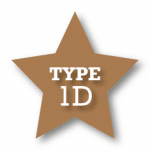 CMT1D is caused by mutations in a gene on chromosome 10 called EGR2, which codes for the early growth response protein 2. CMT1D is very rare and causes less than 1 percent of cases of CMT. Most people with CMT1D show severe symptoms in the first decade of life, including delayed motor milestones and nerve conduction velocities of 10 m/s or less (sometimes referred to as Dejerine Sottas syndrome). A few cases of CMT1D have milder symptoms that appear later in life. Other symptoms may include cranial nerve dysfunction and respiratory difficulties. There have been extremely rare reports of EGR2 causing an autosomal recessive form of CMT, termed CMT4E.
CMT1D is caused by mutations in a gene on chromosome 10 called EGR2, which codes for the early growth response protein 2. CMT1D is very rare and causes less than 1 percent of cases of CMT. Most people with CMT1D show severe symptoms in the first decade of life, including delayed motor milestones and nerve conduction velocities of 10 m/s or less (sometimes referred to as Dejerine Sottas syndrome). A few cases of CMT1D have milder symptoms that appear later in life. Other symptoms may include cranial nerve dysfunction and respiratory difficulties. There have been extremely rare reports of EGR2 causing an autosomal recessive form of CMT, termed CMT4E.
 Point mutations in the PMP22 gene cause CMT1E. People with CMT1E tend to have earlier onset and more severe symptoms than those with CMT1A, but this may vary. Conduction velocities in patients tend to be markedly reduced, usually under 10 m/s (normal in the arms is >50 m/s). Children often present within the first two years of life with delayed walking. Many people do progress to needing ambulation aids, such as a walker or a wheelchair, earlier than those with CMT1A. CMT1E is a rare form of CMT, accounting for approximately one percent of people with genetically confirmed CMT.
Point mutations in the PMP22 gene cause CMT1E. People with CMT1E tend to have earlier onset and more severe symptoms than those with CMT1A, but this may vary. Conduction velocities in patients tend to be markedly reduced, usually under 10 m/s (normal in the arms is >50 m/s). Children often present within the first two years of life with delayed walking. Many people do progress to needing ambulation aids, such as a walker or a wheelchair, earlier than those with CMT1A. CMT1E is a rare form of CMT, accounting for approximately one percent of people with genetically confirmed CMT.
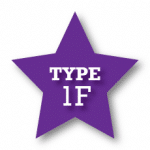 CMT1F accounts for a very small percentage of cases. It is an autosomal dominant form of CMT in which the defect is on Chromosome 8 and the neurofilament light chain protein.
CMT1F accounts for a very small percentage of cases. It is an autosomal dominant form of CMT in which the defect is on Chromosome 8 and the neurofilament light chain protein.
 CMT1X is the second most common form of CMT, accounting for 10 – 16 percent of all cases. The gene that causes CMT1X is GJB1 (previously referred to as Cx32), and the protein is called connexin 32. This gene is found on the X chromosome, one of the sex chromosomes. Females have two X chromosomes (XX) and males have an X and a Y chromosome (XY). Because males only have one copy of the X chromosome, they only have one copy of this gene. If there is a variant in the gene that causes it not to work, males do not have a “backup” copy to help make connexin 32 protein. Females have an extra copy of the gene. Females tend to be less severely affected than the males in their family, but 90 percent have some symptoms. About two-thirds of affected women have symptoms in the mild range and one-third have symptoms in the moderate range. Most males have moderate to severe neuropathy as they age.
The CMT genes found on the X chromosome have a different form of inheritance, called X-linked inheritance. In every pregnancy, the female passes down one copy of a chromosome pair and her partner passes down the other copy for the pair. In order for a child to be born female, she must inherit the X chromosome from her dad. In order for a child to be born male, he must inherit the Y chromosome from his dad. A woman will pass down one or the other of her two X chromosomes in every pregnancy. Each child of a woman affected with CMT1X has a 50/50 risk of inheriting the condition, no matter the sex of the child. A man affected with CMT1X will pass it on to ALL of his daughters (since they inherit his X chromosome with the GJB1 gene variant), but NONE of his sons (who inherit the Y chromosome which does not have a GJB1 gene). The sex of the parent or the child ONLY matters in X-linked inheritance.
CMT1X is the second most common form of CMT, accounting for 10 – 16 percent of all cases. The gene that causes CMT1X is GJB1 (previously referred to as Cx32), and the protein is called connexin 32. This gene is found on the X chromosome, one of the sex chromosomes. Females have two X chromosomes (XX) and males have an X and a Y chromosome (XY). Because males only have one copy of the X chromosome, they only have one copy of this gene. If there is a variant in the gene that causes it not to work, males do not have a “backup” copy to help make connexin 32 protein. Females have an extra copy of the gene. Females tend to be less severely affected than the males in their family, but 90 percent have some symptoms. About two-thirds of affected women have symptoms in the mild range and one-third have symptoms in the moderate range. Most males have moderate to severe neuropathy as they age.
The CMT genes found on the X chromosome have a different form of inheritance, called X-linked inheritance. In every pregnancy, the female passes down one copy of a chromosome pair and her partner passes down the other copy for the pair. In order for a child to be born female, she must inherit the X chromosome from her dad. In order for a child to be born male, he must inherit the Y chromosome from his dad. A woman will pass down one or the other of her two X chromosomes in every pregnancy. Each child of a woman affected with CMT1X has a 50/50 risk of inheriting the condition, no matter the sex of the child. A man affected with CMT1X will pass it on to ALL of his daughters (since they inherit his X chromosome with the GJB1 gene variant), but NONE of his sons (who inherit the Y chromosome which does not have a GJB1 gene). The sex of the parent or the child ONLY matters in X-linked inheritance.